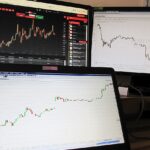Position trading is a popular trading strategy used by many investors and traders in the financial markets. It involves holding a position in a particular security for an extended period, ranging from weeks to even years. This approach focuses on capturing larger moves in the market rather than short-term fluctuations. In this article, we will discuss the defining characteristics of position trading, how it differs from other trading strategies, and provide some frequently asked questions related to this trading style.
Defining Characteristics of Position Trading
1. Long-Term Perspective: Position traders have a long-term perspective on the market. They aim to benefit from major trends and price movements, which take a considerable amount of time to develop. This strategy requires patience and an ability to withstand short-term market fluctuations.
2. Reduced Number of Trades: Unlike day traders who make multiple trades in a day, position traders aim to limit their trading activity. They typically focus on a few high-probability opportunities and hold their positions for an extended period. By reducing the number of trades, position traders aim to minimize transaction costs.
3. Fundamental Analysis: Position trading relies heavily on fundamental analysis to identify potential investments. Fundamental factors such as economic indicators, company financials, industry trends, and market conditions play a significant role in determining the attractiveness of a position trade.
4. Diversification: Position traders often have a diversified portfolio consisting of different asset classes, sectors, or geographic regions. Diversification helps reduce risk and provides exposure to a wide range of opportunities. By spreading investments across various securities, position traders can capture potential gains while mitigating losses.
How Position Trading Differs from Other Trading Strategies
1. Day Trading: Day trading involves buying and selling securities within the same trading day. Unlike position trading, day traders are focused on short-term price movements and aim to profit from intraday volatility. Day traders often have high trading frequency and use technical analysis techniques to make quick trading decisions.
2. Swing Trading: Swing trading falls between position trading and day trading. Swing traders aim to capture shorter-term price swings that occur within a trend. They typically hold positions for a few days to a couple of weeks, compared to the weeks to years holding period of position traders. Swing traders often use a combination of technical and fundamental analysis to identify potential entry and exit points.
3. Scalping: Scalping is an extremely short-term trading strategy where traders aim to make small profits from small price movements. Scalpers hold positions for a few seconds to minutes. Unlike position trading, scalping requires quick decision-making, advanced technical analysis skills, and access to real-time market data.
Comparing Alternative Trading Strategies
| Strategy | Holding period | Trading Frequency | Focus | Analysis |
| Position Trading | weeks to years | low | long term | fundamental |
| Day Trading | same day | high | short-term | technical |
| Swing Trading | days to weeks | medium | medium-term | both |
| Scalping | seconds to minutes | very high | very short | technical |
FAQs (Frequently Asked Questions)
1. Is position trading suitable for beginners?
Position trading can be suitable for beginners who have a long-term perspective and patience. However, it is important to have a good understanding of fundamental analysis and risk management before venturing into position trading.
2. How do I choose stocks for position trading?
When choosing stocks for position trading, it is essential to focus on strong fundamentals, industry trends, and outlook. Conduct thorough research, analyze financial statements, and consider the company’s competitive position before making any investment decisions.
3. What is the suitable capital requirement for position trading?
Position trading typically requires a larger capital base compared to day trading or scalping due to the longer holding period. The exact capital requirement may vary based on individual risk tolerance, but having sufficient capital to withstand potential drawdowns is important.
4. How do I manage risk in position trading?
Risk management is crucial in position trading. Position traders often use techniques such as setting stop-loss orders, diversifying their portfolio, and employing proper position sizing. Regular monitoring of positions and adjustments based on changing market conditions is also important.
Conclusion
Position trading is a trading strategy that emphasizes long-term investment opportunities and capturing major trends in the market. It requires patience, fundamental analysis skills, and the ability to withstand short-term market fluctuations. Compared to other trading strategies like day trading or scalping, position trading has a lower trading frequency and focuses on capitalizing on larger price movements. By understanding the basics of position trading, investors can make informed decisions and potentially benefit from the long-term growth potential of the financial markets.







